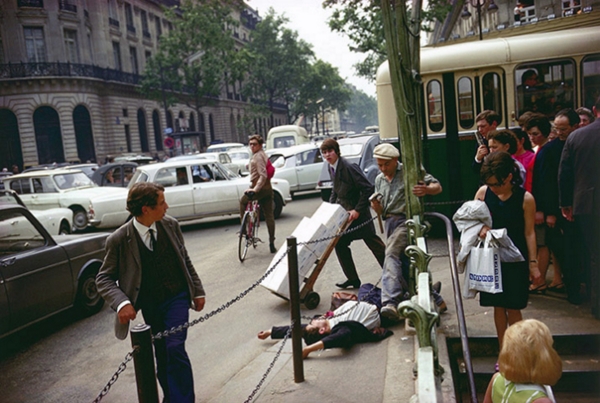This post is part of a series of blog posts called "Noteworthy Artists and
Artworks". For more information about the series, please read Series Breakdown:
Noteworthy Artists and Artworks. You can find the link at the end of this post.
Joel Meyerowitz is an American street, portrait and landscape photographer. He
was born in New York, New York on 6th March, 1938. Having exhibited all over the
world he is often credited with being an early adopter of colour photography. In
doing this, Meyerowitz helped weaken the resistance to the idea of colour
photography not being a serious medium for street photography.
Like the other artists I have highlighted in this series, Meyerowitz has created
many pieces over his lifetime. For the sake of brevity, though, I will focus on
just one. That one is a photograph called Fallen Man (fig. 1) which Meyerowitz
took in Paris in 1967.
 Figure 1: Fallen Man, Paris 1967 by Joel Meyerowitz
Figure 1: Fallen Man, Paris 1967 by Joel Meyerowitz
Fallen Man (fig. 1) consists of a falling man – in Paris, 1967. Of all
the artists I tend to gravitate to, Meyerowitz seems to have the most
descriptive titles. Nevertheless, what you see is a man on his back (having
fallen), with a crowd watching and another man (holding a hammer) walking over
him. There is a sense of drama and theatricality to it. However, an important
note to make here is the narration has been coerced by Meyerowitz. The framing
of the scene and the moment documented are choices made by Mayerowitz. To put it
another way, this is Meyerowitz's account of the story. On top of this, the
static nature of photography means we are left to conclude the before and after
ourselves. We can do this, however, with the information Mayerowitz provides.
What I have now come to learn from photographs like this is how to expose the
ambiguities of the world we live in. Or, in other words, photography is really
good at traversing the implicit and the explicit. When you view Fallen Man
(fig. 1) you can assert that a man has fallen onto his back – it is
explicit. How he got there is implied. Thus, the actual reason why will sink
into the vortex of mass opinion as more people attempt to provide an answer
after the fact – whilst never witnessing the moment first-hand.
By being exposed to Meyerowitz’s work and others like his, my belief of letting
things grow (nurturing) has been invigorated. The most notable reason is because
of the implicit and explicit nature as mentioned previously. The concrete nature
of a physical image that is offset by a lack of a "before" and "after" allows,
and actively encourages, the image to grow in ways beyond the initial viewing of
the piece. Mayerowitz does not show several frames at once, he shows one. And,
regardless of how intentional it is of him, confronting work in this manner has
left its mark and influence on how I think about my work.
Links